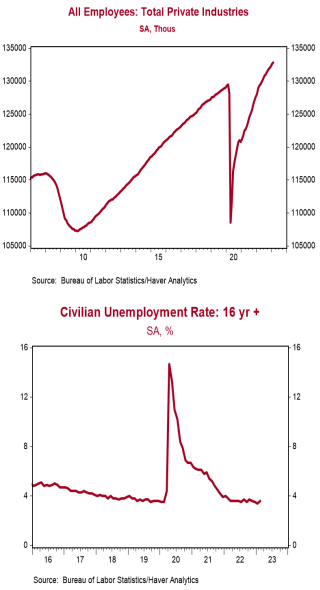- Nonfarm payrolls increased 311,000 in February, beating the consensus expected 225,000. Payroll gains for December and January were revised down by a total of 34,000, bringing the net gain, including revisions, to 277,000.
- Private sector payrolls rose 265,000 in February and were revised down 94,000 in prior months. The largest increases in February were for leisure & hospitality (+105,000), education & health services (+74,000), and retail (+50,000). Manufacturing declined 4,000 while government rose 46,000.
- The unemployment rate rose to 3.6% from 3.4% in January.
- Average hourly earnings – cash earnings, excluding irregular bonuses/commissions and fringe benefits – rose 0.2% in February and are up 4.6% versus a year ago. Aggregate hours declined 0.1% in February and are up 2.5% from a year ago.
Implications:
The job market remained strong in February, but not quite as strong as the headlines suggest. Nonfarm payrolls increased 311,000 in February, beating the consensus expected 225,000. Meanwhile, civilian employment, an alternative measure of jobs that includes small-business start-ups, increased a solid 177,000. The unemployment rate rose to 3.6% from 3.4% in January, but that was due to positive news: an increase in the labor force (people who are either working or looking for work) of 419,000. The labor force participation rate (the share of adults in the labor force) is now 62.5%, the highest since March 2020. So far, so good. However, there were also signs of softness in today’s report. In particular, average hourly earnings rose an unusually small 0.2% and are now up 4.6% from a year ago. The 0.2% gain in February itself was the smallest gain for any month in a year, suggesting that job growth in higher-wage occupations or at higher paying companies has slowed. And although a 4.6% gain in average hourly earnings would normally be good, it’s not a positive sign for worker purchasing power when consumer prices are up more than 6.0% over the same time period. Meanwhile, in spite of an increase in jobs, the total number of hours worked in the private sector declined 0.1% in February. Total private-sector wages, which are a combination of total hours worked and average hourly earnings, were up only 0.2% in February, the smallest increase in two years. When you put it altogether what we have is a labor market that is still strong, but which is showing some signs of softness and is not invulnerable to a recession. The labor market is often a lagging indicator and it may be even more so now because this is the first time in more than twenty years that businesses face heightened recession risk due to tighter monetary policy (rather than mark-to-market rules or COVID lockdowns). In other recent news on the labor market, initial claims for jobless benefits rose 21,000 last week to 211,000. Continuing claims increased 69,000 to 1.718 million, tying the highest level since January 2022. These figures are consistent with a further slowdown in payroll growth in March.





